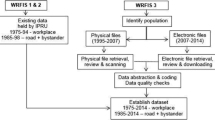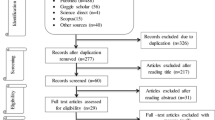Abstract
Background
Despite the efforts of contractors to identify and reduce any occupational risk that exists in subcontracted works, if the associated risks cannot be eliminated and reduced and subcontractors have to take risks, this situation can be called ‘risk transfer.’ The hypothesis of this study is that the contractor–subcontractor status of a company affects the risk of occupational injury or occupational disease. The inside subcontractor and outside subcontractor represent subcontractors located inside and outside the contractor workplace, respectively.
Methods
The dataset from the 9th Occupational Safety and Health Company Survey (OSHCS) with 5219 workplaces, which was conducted in South Korea, was used. After the exclusion of 45 workplaces with no reported employees, 5174 workplaces with a total of 1,072,583 employees were used for analysis. Poisson regression was applied with the contractor–subcontractor category as the independent variable and the number of both occupational injury and disease cases per workplace as the dependent variable. Poisson regression is an appropriate model for the count-data analysis of rare events that do not follow a normal distribution but rather follow a right-skewed distribution.
Results
Compared to the ‘contractor’ category, the ‘outside contractor’ reported the highest risk ratio, 1.66 (95% Confidence Interval, CI 1.09–2.41). The ‘inside contractor’ reported the second highest risk ratio, 1.39 (95% CI 1.07–1.78). In contrast, the ‘both contractor and subcontractor’ category reported a statistically significant decreased risk ratio of 0.69 (95% CI 0.57–0.84). The ‘neither contractor nor subcontractor’ category showed a statistically equivocal risk ratio of 0.91 (95% CI 0.76–1.07).
Conclusion
This study confirmed the increased risk of occupational injuries and diseases for subcontractors, whether located inside or outside the contractor workplace (1.66-fold and 1.39-fold increased risk, respectively). Future individual-based epidemiologic studies such as case–control and cohort studies could provide more detailed information such as specific risk factors associated with subcontracted works and confounders according to industry classification.


Similar content being viewed by others
Availability of data and materials
The used data can be accessed on https://oshri.kosha.or.kr/oshri/researchField/introduction_b.do. However, the homepage and dataset are completely written in Korean.
References
Chelton C, Glowatz M, Mosovsky J (1991) Chemical hazards in the semiconductor industry. IEEE Trans Educ 34(3):269–288
Coxe S, West SG, Aiken LS (2009) The analysis of count data: a gentle introduction to Poisson regression and its alternatives. J Pers Assess 91(2):121–136
Elsler D et al (2010) A review of case studies evaluating economic incentives to promote occupational safety and health. Scand J Work Environ Health 36:289–298
Frome EL (1983) The analysis of rates using Poisson regression models. Biometrics 39:665–674
Gochfeld M, Mohr S (2007) Protecting contract workers: case study of the US Department of Energy’s nuclear and chemical waste management. Am J Public Health 97(9):1607–1613. https://doi.org/10.2105/ajph.2006.108795
Kim KW, Park SJ, Lim HS, Cho HH (2017) Safety Climate and occupational stress according to occupational accidents experience and employment type in shipbuilding industry of Korea. Saf Health Work 8(3):290–295. https://doi.org/10.1016/j.shaw.2017.08.002
Koranyi I, Jonsson J, Rönnblad T, Stockfelt L, Bodin T (2018) Precarious employment and occupational accidents and injuries - a systematic review. Scand J Work Environ Health 44(4):341–350. https://doi.org/10.5271/sjweh.3720
Loosemore M, Andonakis N (2007) Barriers to implementing OHS reforms – the experiences of small subcontractors in the Australian Construction Industry. Int J Project Manage 25(6):579–588. https://doi.org/10.1016/j.ijproman.2007.01.015
Manu P, Ankrah N, Proverbs D, Suresh S (2013) Mitigating the health and safety influence of subcontracting in construction: the approach of main contractors. Int J Project Manage 31(7):1017–1026. https://doi.org/10.1016/j.ijproman.2012.11.011
Mayhew C, Quinlan M (1997) Subcontracting and occupational health and safety in the residential building industry. Ind Relat J 28(3):192–205. https://doi.org/10.1111/1468-2338.00054
Mayhew C, Quintan M, Ferris R (1997) The effects of subcontracting/ outsourcing on occupational health and safety: survey evidence from four australian industries. Saf Sci 25(1–3):163–178. https://doi.org/10.1016/s0925-7535(97)00014-3
Min KB, Park SG, Song JS, Yi KH, Jang TW, Min JY (2013) Subcontractors and increased risk for work-related diseases and absenteeism. Am J Ind Med. https://doi.org/10.1002/ajim.22219
Min J, Kim Y, Lee S, Jang T-W, Kim I, Song J (2019) The fourth industrial revolution and its impact on occupational health and safety, worker’s compensation and labor conditions. Saf Health Work 10(4):400–408
Nunes IL (2012) The nexus between OSH and subcontracting. Work 41(Suppl 1):3062–3068. https://doi.org/10.3233/wor-2012-0564-3062
Salazar MK, Takaro TK, Gochfeld M, Barnhart S (2003) Occupational health services at ten U.S. Department of Energy weapons sites. Am J Ind Med 43(4):418–28. https://doi.org/10.1002/ajim.10196
Salminen S, Saari J, Saarela KL, Räsänen T (1993) Organizational factors influencing serious occupational accidents. Scand J Work Environ Health 19(5):352–357. https://doi.org/10.5271/sjweh.1463
Tran M, Sokas RK (2017) The gig economy and contingent work: an occupational health assessment. J Occup Environ Med 59(4):e63
United_States_Bureau_of_Labor (1994–1995) National census of fatal occupational injuries. Washington, DC: Bureau of Labor Statistics
Yoon C (2012) Much concern but little research on semiconductor occupational health issues. J Korean Med Sci 27(5):461
Acknowledgements
None.
Funding
This research did not receive any specific grant from funding agencies in the public, commercial, or not-for-profit sectors.
Author information
Authors and Affiliations
Contributions
Conceptualization, Methodology, Software, Validation, Formal Analysis, Investigation, Resources, Data Curation, Writing—Original Draft, Writing—Review & Editing, Visualization, Supervision, Project Administration: Jinyoung Moon.
Corresponding author
Ethics declarations
Conflict of interest
The authors have no potential conflicts of interest to disclose.
Additional information
Publisher's Note
Springer Nature remains neutral with regard to jurisdictional claims in published maps and institutional affiliations.
Glossary
-
1.
Contractor: a company that subcontracts their work to other subcontractor companies.
-
2.
Both contractor and subcontractor: a company that is a contractor for some companies and a subcontractor for some other companies.
-
3.
Inside subcontractor: a subcontractor located inside the contractor workplace.
-
4.
Outside subcontractor: a subcontractor located outside the contractor workplace.
-
5.
Neither contractor nor subcontractor: a company that is not a contractor or a subcontractor. These companies contact consumers directly without any contractor or subcontractor.
-
6.
Risk transfer: Despite the efforts of contractors to identify and reduce any occupational risk that exists in the subcontracted works, if the associated risks cannot be eliminated and reduced and subcontractors have to take risks, this situation could be called ‘risk transfer.’
-
7.
Unfair risk transaction: If the remaining risk is transferred from a contractor to its subcontractors without appropriate benefit in return, this situation could be called an ‘unfair risk transaction.’
Supplementary Information
Below is the link to the electronic supplementary material.
Rights and permissions
About this article
Cite this article
Moon, J. The effect of subcontractor status on occupational injury and disease incidence: a cross-sectional study using the 9th Occupational Safety and Health Company Survey. Int Arch Occup Environ Health 95, 1003–1016 (2022). https://doi.org/10.1007/s00420-022-01858-4
Received:
Accepted:
Published:
Issue Date:
DOI: https://doi.org/10.1007/s00420-022-01858-4




